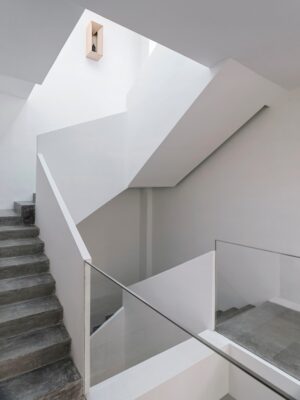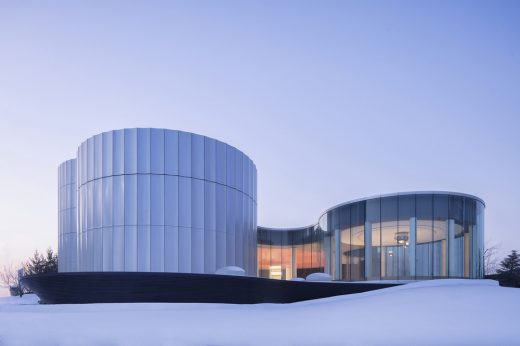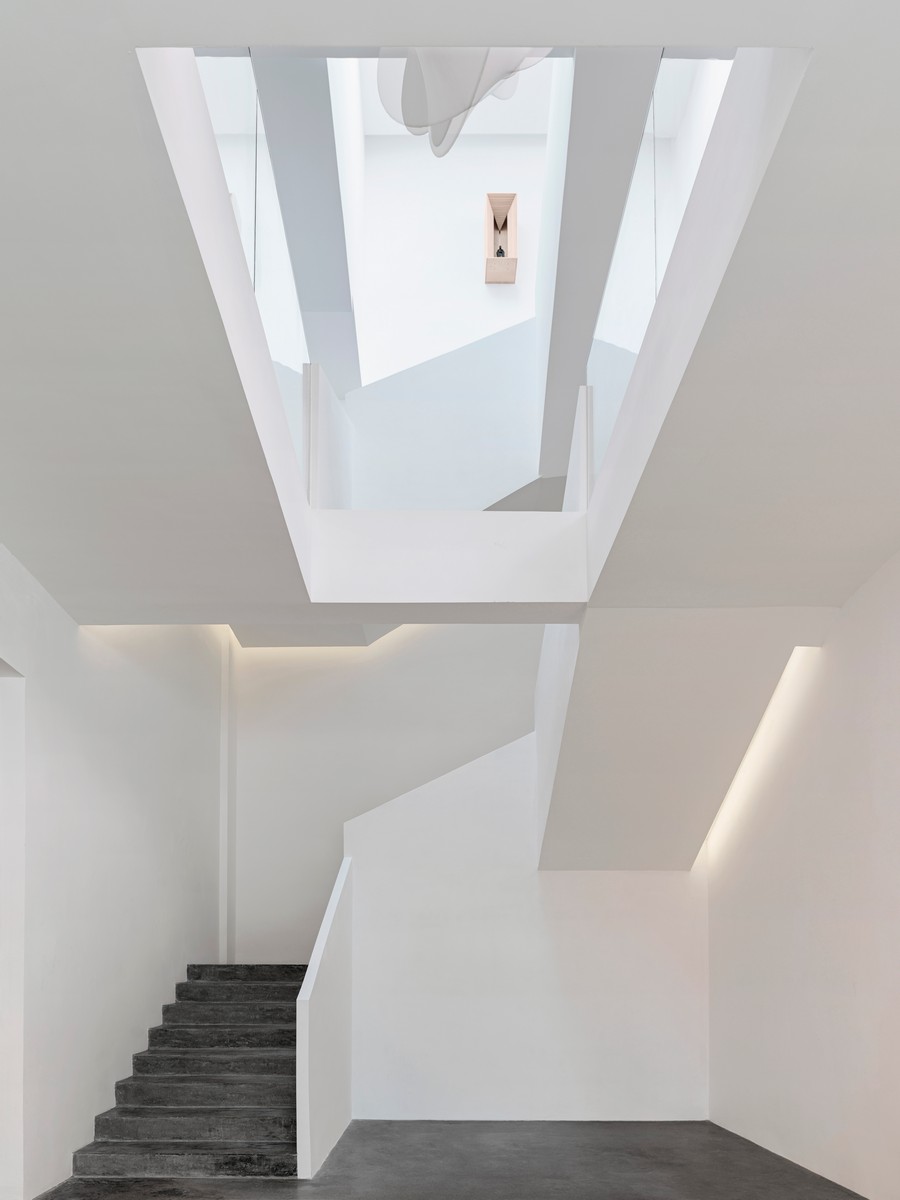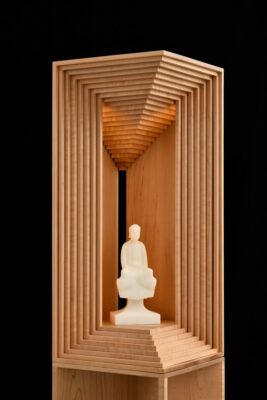Loutijian Buddha Altar China, Jiang Sheng Artist, Chinese Modern Design, Interior Architecture Photos
Loutijian Buddha Altar Design
26 Apr 2022
Another “Residence” of the Buddha
Design: TEAM_BLDG, architects
Location: China
Loutijian Buddha Altar in China for Jiang Sheng in The Field:

photograph : Jonathan Leijonhufvud
Photos by Xu Xiaodong, Jonathan Leijonhufvud, TEAM_BLDG
Loutijian Buddha Altar, China
In early summer of 2020, the artist Jiang Sheng commissioned TEAM_BLDG to design the Buddha altar for his newly built studio and exhibition space “The Field”.
Loutijian Buddha Altar in China for Jiang Sheng in The Void:

photograph : Jonathan Leijonhufvud
ORIGIN
There is a scene described in the translation of Buddhist Scripture BUDDHA DHYANA SAMADHISAGARA SUTRA, “There are countless niches on Sumeru Mountain, in which there are innumerable incarnation of the Buddha.” As the scripture says, since the prosperity of Buddhism, ancient Chinese Buddhists were good at carving different sizes niches on the mountains for placing and worshiping Buddha. People have been praying and pouring out their wishes to the Buddha for peace and happiness. Later, with the progress of society and technology, people began to use the stone and wood to carve the altars, most of them are complicated and delicate, solemn and serene.
However, compared with traditional Buddha altar, Jiang Sheng has his own understanding and aspiration. Jiang loves traveling and often shares his travel experiences with us. Over time, the mutual understandings between us became a palm driving the design. For example, he once mentioned that many Buddhists in Tibet and Southeast Asia have their own small altar to carry around. To those Buddhists, small altars are not too solemn or dignified to approach. Instead, altars are bridges for them to get close to the Buddha and to introduce the Buddhism into daily life.
Loutijian Buddha Altar in The Void:

photo : Jonathan Leijonhufvud
MAKING ALTARS
CONSTRUCT
TEAM_BLDG worked on the design of altar with the intention to build a residence for the Buddha. In the literature reading, one of the landmark buildings of ancient Indian civilization, Indian stepwell inspired us. Stepwells were built as water storage space in ancient India. The layered structure and exquisitely carved stone brick are so impressive that could rival the magnificent temples and palaces of the same period. Furthermore, it is closely related to the daily life of ancient Indian people, religious rituals and folklore. It contains the profound wisdom of a foreign nation.
Referring to the composition of Indian stepwells, TEAM_BLDG fabricated the orderly overlapping cyclic structure with layers pushing from all sides to create a visual extension centered on the statue of Buddha. The centripetal presence along with the warm color of maple wood bring out sense of ritual and the mood of tranquility.
Loutijian Buddha Altar in The Field:

photo : Jonathan Leijonhufvud
DIFFUSED LIGHT
People tend to have infinite imagination about light. For the architecture, light introduces interplay among people, the objects and the space. When designing the Buddha altar, TEAM_BLDG also defined it as a lamp and light need to be put inside.
After the works are done, user could turn on the switch by touching the strip of tablet. Illuminant of the Buddha altar is hidden from view and the light projected from it diffusing through gaps presents mild and illusory brightness which likes being in a cave. It plays as a link between divinity and everyday routine.
Loutijian Buddha Altar in The Field, China:

photo : Jonathan Leijonhufvud
LAMP
It is The Jiangs’s original aspiration to create the Buddha statue less condescending for more people’s normal life. So the Buddha alter he expected is no longer the alter for worship and has nothing to do with sacred aura of religion.
Based on that, we tried to make the altar looks like a lamp or a piece of furniture that fit for users daily space with less dignity of religious object and more approachable. It is the residence of Buddha, but also a lamp, a part of an ordinary home.
PRESENTING
The finished Buddha altar was used for the first time in the stairwell of “The Field” . For this reason, we named it the Loutijian Buddha Altar.
At the end of 2020, two models of Buddha Altars designed by TEAM_BLDG, the Loutijian Plane Buddha Altar and the Loutijian Corner Buddha Altar, made their debuts in Jiang Sheng’s exhibition Void , held in Dome Studio, Beijing, which the exhibition space was also designed by TEAM_BLDG. The altars produced both tangible and invisible connections between the Buddha statues and the space, and among everything and everyone in the space. By the design logic and the cyclic structure with layers pushing from all sides, Void, in Chinese “the empty room”, was connected to the Buddhist alters in a subtle and mysterious way.
CHALLENGE
When we designed the Buddha altar as an architect, it was quite challenging in the process of turning the drawing into real subject as we had to go through revisions and communications on feasibility. The carpenters prefer to discuss about revision in the factory face to face, while architects are used to computer graphics. As the products are made by hand, in order to move to next step, we had to mail the wooden proof back and forth every time to check the scale then update the drawing. On the other hand, we had to work on both wooden proofing and light installation at the same time. In the production of the stepped appearance of the altar, issues like uneven gaps between the steps once happened that undermined the overall evenness of light.
For the works of TEAM_BLDG, we have been hoping that architecture, space, furniture or product could be in the discussion of a more unified context, that we could blur the design boundaries, therewith we also involve more fields besides the architecture. By continuous and complete design expression, our architects could provide better user experience.Now, through the Buddha statue, our design extended to exhibition space, interior and architecture. And the Buddha altar is another attempt of expansion in furniture design.
Loutijian Buddha Altar in The Void, China:

photo : Jonathan Leijonhufvud
Loutijian Buddha Altar in China – Building Information
Product Name: Loutijian Buddha Altar | Another “Residence” of the Buddha
Function: Buddha Altar, Furniture, Lamp
Design Period: 2020.05 – 2020.07
Production Period: 2020.07 – 2020.09
Designers: Xiao Lei, Shi Jiaxin, Yang Yuqiong
Photographs: Xu Xiaodong, Jonathan Leijonhufvud, TEAM_BLDG
Loutijian Buddha Altar in China for Jiang Sheng images / information received 260422 from TEAM_BLDG Architects
Location: China, eastern Asia
Architecture in China
China Architecture Designs – chronological list
Chinese Architecture Designs – architectural selection below:
Chinese Architect – Design Practice Listings
Shanghai Architecture Walking Tours
Yantai Experience Centre
Architects: More Design Office

photography by Hai Zhu, Zhi Xia
Yantai Experience Centre Shandong
Zaozhuang Citizen Service Center, Minsheng Road, Xuecheng District, Zaozhuang
Design: Shanghai United Design Group Co., Ltd. (UDG)

photo © MLEE STUDIO
Zaozhuang Citizen Service Center, Shandong
Chinese Architecture Designs
Comments / photos for the Loutijian Buddha Altar in China for Jiang Sheng – New Chinese Architecture designed by TEAM_BLDG page welcome






